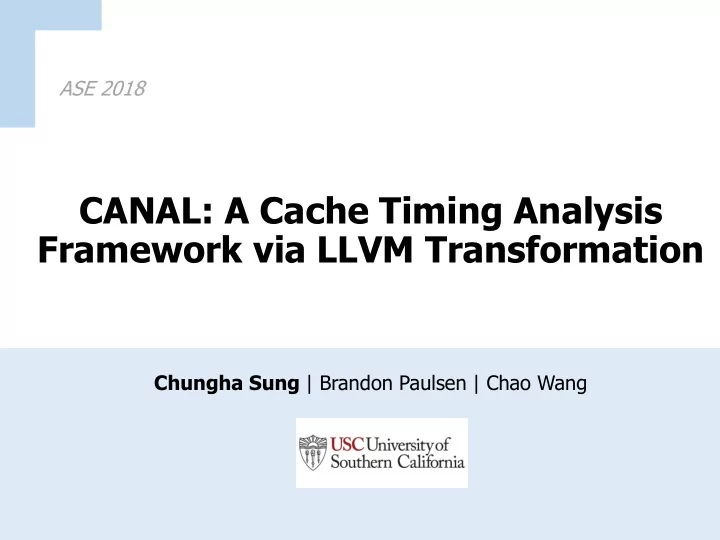

ASE 2018 CANAL: A Cache Timing Analysis Framework via LLVM Transformation Chungha Sung | Brandon Paulsen | Chao Wang
Software verification & analysis Checking Functional Model properties Checking Ex) Abstract assert(x > 1); Interpretation Symbolic Execution
Software verification & analysis Non-functional Properties Model e.g. Cache behavior Checking Ex) Abstract The number of Interpretation cache misses? Symbolic Execution
Software verification & analysis Model Checking You’d have to Abstract change each of Interpretation these tools to model cache behavior Symbolic Execution
CANAL Model Checking Abstract Interpretation Symbolic LLVM-Transformation Execution 1. Now, cache (and other non-functional) properties can be handled by existing verifiers 2. General (not tool-specific) cache modeling framework
Overview Memory Layout C/C++ Clang LLVM Instrumented Code Bitcode LLVM Pass LLVM Bitcode Code Instrumentation & Cache Computation Header Cache cSim.h Configure generator Verification tools (SMACK, KLEE, Crab- llvm etc.) Canal process
Code instrumentation T = Y; (Inserted function calls below) __CSIM_Load (address set of “Y”, address tags of “Y”); __CSIM_Store (address set of “T”, address tags of “T”); Code instrumentation is done at the LLVM-Bitcode level
Outline ▪ Motivation ▪ Code Instrumentation ▪ Usages ▪ Use CANAL as a simulator (omitted) ▪ Use CANAL with Symbolic execution tool ▪ Use CANAL with Static analysis tool ▪ Use CANAL with Software verification tool ▪ Conclusion
Usage 1 – Symbolic execution tool CANAL Instrumented LLVM Bitcode Symbolic execution tools (e.g Klee) Check if there exist two inputs that lead to different cache stats (Side-channel leakage)
Usage 1 – Symbolic execution tool (Cont’d) klee_make_symbolic(&input1); klee_make_symbolic(&input2); __CSIM_init_cache(); call_program1(input1); h1 = __CSIM_num_hit; m1 = __CSIM_num_miss; __CSIM_init_cache(); call_program1(input2); h2 = __CSIM_num_hit; m2 = __CSIM_num_miss; assert(h1 == h2 && m1 == m2);
Usage 1 – Symbolic execution tool (Cont’d) klee_make_symbolic(&input1); Define symbolic inputs klee_make_symbolic(&input2); __CSIM_init_cache(); call_program1(input1); h1 = __CSIM_num_hit; m1 = __CSIM_num_miss; __CSIM_init_cache(); call_program1(input2); h2 = __CSIM_num_hit; m2 = __CSIM_num_miss; assert(h1 == h2 && m1 == m2);
Usage 1 – Symbolic execution tool (Cont’d) klee_make_symbolic(&input1); klee_make_symbolic(&input2); __CSIM_init_cache(); Cache status initialization Input 1 call_program1(input1); Run program and get cache stats h1 = __CSIM_num_hit; m1 = __CSIM_num_miss; __CSIM_init_cache(); call_program1(input2); h2 = __CSIM_num_hit; m2 = __CSIM_num_miss; assert(h1 == h2 && m1 == m2);
Usage 1 – Symbolic execution tool (Cont’d) klee_make_symbolic(&input1); klee_make_symbolic(&input2); __CSIM_init_cache(); call_program1(input1); h1 = __CSIM_num_hit; m1 = __CSIM_num_miss; __CSIM_init_cache(); Cache status initialization Input 2 call_program1(input2); h2 = __CSIM_num_hit; Run program and get cache stats m2 = __CSIM_num_miss; assert(h1 == h2 && m1 == m2);
Usage 1 – Symbolic execution tool (Cont’d) klee_make_symbolic(&input1); klee_make_symbolic(&input2); __CSIM_init_cache(); call_program1(input1); h1 = __CSIM_num_hit; m1 = __CSIM_num_miss; __CSIM_init_cache(); call_program1(input2); h2 = __CSIM_num_hit; m2 = __CSIM_num_miss; assert(h1 == h2 && m1 == m2); Check stats are the same
Usage 2 – Software verification tool CANAL Instrumented LLVM Bitcode Software verification tool (e.g SMACK) Check if a memory read or write always leads to cach hit/miss (MUST hit/miss analysis)
Usage 2 – Software verification tool ( Con’d ) if (cond) buffer[0] = 1; else buffer[16] = 1; x = buffer[2]; h = __CSIM_Load_ret; assert (h == true); Check: Read of buffer[2] always leads to cache hit?
Usage 2 – Software verification tool ( Con’d ) if (cond) buffer[0] = 1; else buffer[0] and buffer[16] are in different cache line buffer[16] = 1; x = buffer[2]; h = __CSIM_Load_ret; assert (h == true);
Usage 2 – Software verification tool ( Con’d ) if (cond) buffer[0] = 1; else buffer[16] = 1; x = buffer[2]; h = __CSIM_Load_ret; buffer[2] will be the first cache line access when the branch was not taken. assert (h == true);
Usage 2 – Software verification tool ( Con’d ) if (cond) buffer[0] = 1; else buffer[16] = 1; x = buffer[2]; h = __CSIM_Load_ret; assert ( h == true); Read the cache status of the last Load/Store operation
Usage 3 – Static analysis tool CANAL Instrumented LLVM Bitcode Static analysis tool (e.g Crab-llvm) Compute invariants over cache stats (e.g., min/max of cache hits/misses)
Usage 3 – Static analysis tool ( Con’d ) if (cond) buffer[0] = 1; else buffer[16] = 1; buffer[2] = 1; s_h = __CSIM_num_Store_hit; s_m = __CSIM_num_Store_miss; assert (s_h > 1); assert (s_m < 3); assert (s_h + s_m == 2);
Usage 3 – Static analysis tool ( Con’d ) if (cond) buffer[0] = 1; else buffer[16] = 1; buffer[2] = 1; s_h = __CSIM_num_Store_hit; s_m = __CSIM_num_Store_miss; assert ( s_h > 1); assert ( s_m < 3); assert ( s_h + s_m == 2); Check invariants over the number of cache hits and misses.
Conclusions • Proposed a unified framework for modeling cache behaviors through LLVM-transformation • CANAL can be used as a simulator without losing accuracy • CANAL can be used tougher with various software verification tools
Thank you! https://github.com/canalcache/canal
Recommend
More recommend